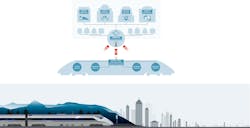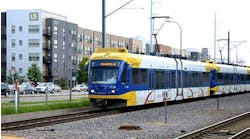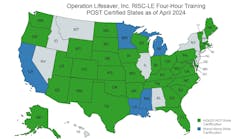Do it faster, do it cheaper, do it greener.
Transit authorities face these increasing pressures every day, charged with supporting local and regional economic growth by moving human capital more efficiently than other metropolitan areas. Rail transporation is benefitting from a series of new technologies that save energy, reduce maintenance costs and improve the passenger experience.
Catenary-free operation (CFO) is driven by the desire to improve aesthetics. Wires and supports blemish the view of historic or architecturally pleasing urban locations, and municipalities and transit authorities would love to eliminate them as much as possible. Introduced about four years ago in Europe, CFO is gaining traction here as technology improves.
Catenary-free gains ground in North America
Henry Wesling, in the business development department of Bombardier Transportation's propulsion group, said battery power is the most popular CFO method. The company last fall contracted with Saft to provide batteries for 26 five-car EMU train sets for use in the south of England.
Batteries are typically charged in a wayside overnight, then use regenerative braking technology to recharge during runs. Additional charging stations can be set up at stations with a single, unobstrustive catenary for quick refreshers along the way. Wesling said batteries can power a train for 2-3 miles before recharging is necessary.
There isn't a maintenance cost associated with a battery, Wesling said, but they are expensive to replace and their shelf life depends greatly on the care they're given. Optimizing cooling and heating cycles, and charging/discharging cycles, can allow a battery to last up to eight years. And by then, advances in battery technology are likely to reduce their size — they usually sit on the roof of a car — and provide even greater efficiency.
The Southest Pennsylvania Transit Authority — SEPTA — does not have CFO for its eight light rail/trolley routs or its 13 regional rail lines, and has no plans to go wireless at any time in the near future. But the organization is combining a series of advanced technologies to not only save and store energy, but generate revenue.
The process starts with regenerative braking, capturing the heat energy produced when the trains slow and stop. But instead of simply using that power to feed the train or nearby trains, SEPTA eyed a larger opportunity.
Using a 400 megawatt battery from Saft and a controller produced by ABB Envitech stored together at a wayside, SEPTA captures the regenerative braking power for two purposes. First, it helps power the wayside and cuts energy costs. Andy Gillespie, SEPTA's chief engineer, said the substation uses 12-13 percent less electricity than before.
SEPTA also uses the stored energy for frequency regulation, essentially selling power on an as-needed basis to PJM Interconnect, which coordinates the movement of power in 13 states on the East Coast. PJM needs to keep its power grid balanced between supply and demand, a process made more challenging by the use of alternative — and wildly variable — sources such as wind and solar power. The energy from SEPTA's wayside energy storage is more reliable than alternative energy and quicker to access than traditional forms. Hence, it's something PJM will pay for.
According to a blog on its website, SEPTA anticipates generating as much as $250,000 a year from frequency regulation and other demand response programs.
Gillespie said SEPTA hopes to install a second battery by the end of 2014, and eventually have 10-15 units installed across the network.
Supercapacitors gain traction
A similar project was installed in Portland this October, using a supercapacitor, instead of batteries, to store and then use regenerative braking power. Siemens' Sitras SES storage unit will not actually be functional until 2015, when the Tri-Met system's new Portland-Milwaukie line opens. The Tri-Met system has long used regenerative braking power, but now this power will be stored to maintain a constant voltage across the entire network, which expands to 60 miles when the new line opens.
In 2010, TriMet was awarded a $4.2 million federal grant to install new energy storage units on 20 of its light rail MAX vehicles, which capture and store nearly all of the energy generated by the braking systems.
Other major metropolitan systems in North America are using new technology to save maintenance costs no matter the propulstion system. Toronto and Chicago are employing a Bombardier product called Orbiflo, a train-to-wayside solution designed to dramatically reduce the time needed to identify, and hence fix, a problem.
Typically, a light rail vehicle (LRV) has a monitoring system for the operator. Orbiflo also connects with the wayside, so every time the car passes the station, or goes into the shop, the maintenance crew can begin working on a solution. That results in less labor time, less down time for the cars, and greater efficiency for customers.
Bombardier's Wesling said Chicago will tie the system not just to metro trains, but also to its bus system.
Lower maintenance cost is also a benefit of another new Bombardier development, the permanent magnet motors. While typical motors are cooled by having air blown through them, the PMMs are completely enclosed and air is blown over them. When no air is blown through, neither is debris, preventing the need to take the motor off the car, clean it and replace bearings. Wesling said PMMs can last almost double the 6-7 years a traditional motor goes between cleanings.
Naturally these modern technologies have a greater up-front cost that can be offputting to some transit authorities and municipalities. Wesling said in Japan and Europe, where conserving energy is emphasized far more, long-term savings are given more consideration than in the United States.
“In the U.S., a customer writes a spec and the low price wins the order,” Wesling said. “One of the jobs I have is to convince the customer to put this into the specs.”
As new CFOs and innovative maintenance and energy-saving solutions begin to appear more frequently around the United States, it's clear some of those customers are listening.




